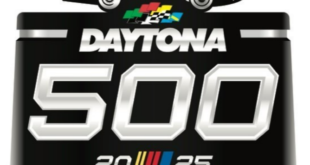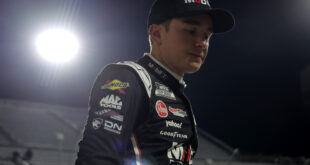ORIGINALLY PUBLISHED ON FEBRUARY 20, 2016
It was bound to happen, whether it’s better late than never is up for debate. But, NASCAR finally decided to eliminate the grey area when it comes to conduct for drivers, team member, officials, and anyone involved in the sport. After years of incidents that repeated themselves between drivers, and even after “boys have at it” became the theme.
Brian France decided that the opening night of the points season for the sport was the appropriate time to get this policy in place.
“What you’ll see is an effort by the sanctioning body to improve the level of transparency within the realms of how competitors’ actions are dealt with on the track and off the track,” said Jim Cassidy, senior vice president, racing operations at NASCAR. “What you’ll see is what I believe is an evolution of the rules. Across the board, we’re becoming more transparent to competitors, for all the participants involved, all the stakeholders involved and for everybody to understand what the playing field is.”
So let’s break this down, and give examples of past incidents that could fall in each category of this new policy, and what could have been the aftermath if that penalty was enforced.
First, the actual rule book changes begins not with what they are, but the reasoning behind it. It reads as such:
- “NASCAR membership is a privilege. With that privilege comes certain benefits, responsibilities and obligations. Correct and proper conduct, both on and off the race track, is part of a Member’s responsibilities. A Member’s actions can reflect upon the sport as a whole and on other NASCAR Members. Ideally, NASCAR Members are role models for the many fans who follow this sport, regardless of the type of license a Member may hold, or the specific Series in which a Member may participate. Therefore, NASCAR views a Member’s conduct, both on and off the race track, which might constitute a behavioral rules violations under this Rule Book with great importance.”
Being part of the sport is a privilege, something that never needed put in writing. The reason, the teams that hire these individuals know they are privileged to have their position, as they were hired for their ability and feeling that they are the best for the job. Now, it is not just an unwritten rule, but now it is in print.
Now, NASCAR has decided to break down the type of infractions, because no incident is similar to the next, and some are much worse than what many may see from the outside.
Section 12.8.1 breaks down infractions and penalties in a very fair, and very intelligent manner. Let’s look at each section, followed by analysis.
- a. Member action(s) that could result in a mild response such as a meeting, warning, probation:
- Heat-of-the-moment action, or reaction, either on or off track.
- Member-to-member confrontation(s) without physical violence (shoving, shouting, “venting”).
This is what is seen every week if something doesn’t go the right way of a driver in an incident. Ideas could be used such as when Kevin Harvick pushed Jimmie Johnson after the Chicagoland race last season, or the disagreement between Joey Logano and Ryan Newman a few seasons back.
Eventually, cooler heads prevail, and the focus becomes the next race and possibly talking it over in private, without the need of a mediator to actually bring the two, or more, individuals together to come to a truce.
- b. Member actions that could result in a $10,000-$50,000 fine and/or probation:
- Disparaging the sport and/or NASCAR’s leadership.
- Verbal abuse of a NASCAR official, media member, fans, etc.
- Intentionally damaging a vehicle under yellow or red flag conditions, or on pit road with no one around.
It has been clear for many years that questioning the leadership of NASCAR, or anything that happens within the sport, is frowned upon. Case-in-point: Denny Hamlin’s remarks of the Gen-6 car in 2013, and his refusal to pay the ensuing fine. So in this case, the punishment fits the crime.
When it comes to verbal abuse of an official or media member, Kurt Busch has two incidents that are lingering with him. In his final race with Penske, after losing his transmission just a couple laps into the Homestead race, when Dr. Jerry Punch tried to get an interview with him, he cussed him out and walked away. The following year, he had a verbal confrontation with Sporting News reporter Bob Pockrass.
Back in 2012, that incident was enough to park Busch for the Pocono weekend. Now, depending on circumstances, a driver could still race the following week.
Finally, the last ruling could still be a vague area, simply because it doesn’t list incidents after the race. Reason being, Brad Keselowski vs. Matt Kenseth, Denny Hamlin and Tony Stewart at Charlotte in 2014. There were no individuals around on pit road, however when the cars made it into the garage area and to the haulers, things escalated. It also got physical between Kenseth and Keselowski, which is covered in the next section.
Still, NASCAR left some wiggle room when it comes to this particular incident, and may need looked at again.
- c. Member actions that could result in a loss of 25-50 Championship driver and Team Owner points and/or $50,000-$100,000 fine and/or one Race suspension, indefinite suspension, or termination:
- Physical confrontation with a NASCAR official, media member, fans, etc.
- Member-to-member confrontation(s) with physical violence and other violent manifestations such as threat(s) and/or abuse and/or endangerment.
- Attempting to manipulate the outcome of the Race or championship.
- Intentionally wrecking another vehicle, whether or not that vehicle is removed from competition as a result.
There is no grey area in this case, it is black and white. In football, or any other ball sport, touching an official in an aggressive manner will get a player tossed from the game, with more punishment possible. This is a no-brainer for NASCAR, because the officials are much like police, and one doesn’t touch a policeman, because it’s considered “assaulting a police officer.” The same goes for physical violence between drivers, crew members, and so forth.
The greatest example in this case of the member-to-member confrontation is Kurt Busch vs. Jimmy Spencer. The difference is, only Spencer received a one-race suspension.
In today’s standard, both Busch and Spencer would be suspended at the minimum of one week. Considering the history between the two, it likely could have been longer. Spencer threw a punch, which was verified by others in the incident. When audio was played back from Busch’s car, it could hear him making threats, and that would fall in this category by today’s standards.
The last two examples, MWR in 2013, and any incident where video evidence sees a driver retaliate to an on-track incident. The punishment certainly fits the crime in this case.
- Member actions that could result in a loss of 50-100 Championship driver and Team Owner points and/or $150,000-$200,000 fine and/or two Race suspension, indefinite suspension, or termination:
- Targeting another driver who is in a highly vulnerable position, such as already stopped with window net lowered; or whose vehicle has already had one or more of its safety systems affected by crash damage, such as an exposed fuel cell, damaged roll cage, and so on.
- Premeditatedly removing another Competitor from championship contention in a dangerous manner when not racing for position based on the available evidence and specific circumstances of the incident.
- Without limiting the scope, examples could include a Competitor “waiting” for another Competitor and then taking action; taking a trajectory with the vehicle not normally taken such as from pit exit directly up into a vehicle in the racing groove; clearly forcing another Competitor into the wall in an abrupt and unambiguous manner; and so on.
Every one of these listed actions has one thing in common: safety. Whether it is safety for the driver, track personnel, or those in the garage, it is a safety violation. Targeting in any sport is deliberate intention to cause harm, meaning there could be some rage, or payback, involved.
All three of these listed actions could be looked at as part of what happened between Matt Kenseth and Joey Logano. In this case, the punishment fits the crime like a perfect game in baseball. It’s clear, decisive, and no other option is available at this point. What is different now is that NASCAR has something to base a punishment on. But in theory, they did from a few years prior as well.
That incident being when Jeff Gordon wrecked Clint Bowyer at Phoenix, which was clearly intentional, and ruined both of their races in the end.
When it comes to deliberately wrecking another driver, there is always some premeditation in the action, and unfortunately it’s the one that retaliates that gets punished. It’s unfortunate, but it is the absolute truth. Safety is the main reason behind these penalties, because safety of everyone is first priority.
- Member actions that could result in a fine and/or indefinite suspension or termination:
- Public statement and/or communication that criticizes, ridicules, or otherwise disparages another person based upon that person’s race, color, creed, national origin, gender, sexual orientation, marital status, religion, age, or handicapping condition.
- Being charged with or convicted of significant criminal violations (e.g. Domestic Violence, Trafficking, Assault), or having had determinations rendered by criminal or civil authorities that in NASCAR’s judgment necessitate action. NASCAR will not pre-judge guilt or innocence in the criminal or civil legal system, or the guilt or innocence of the Member, but rather review each matter in its own context and circumstances and with regards to its potential effects upon the sport.
What’s lucky about NASCAR is that these incidents rarely happen, even though a year ago Kurt Busch had to sit out the first three races due to charges being brought up on his domestic case. However, there is no grey area here. It is especially clear that if NASCAR feels that something has happened to cause the charges or statement to be valid, they can put a suspension in place.
At the same time, if the driver/member is convicted, the suspension that is first implemented could in all reality be moved up and result in termination from the sport. It’s a very cut-and-dry way to say “You need NASCAR more than NASCAR needs you.”
NASCAR has said “boys have at it” but now they are making sure that if there is something that gets out of line, or is beyond the scope of what the sport represents, there is no hesitation to enforce what they feel is right.
Now, everyone in the sport needs to make sure all their “I’s” are dotted, and “T’s” are crossed, otherwise they will be out money, or at worst, a job.
 All About Horse Power Motorsports 24/7
All About Horse Power Motorsports 24/7



